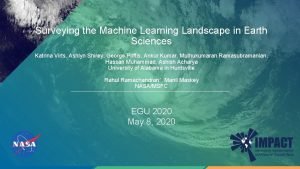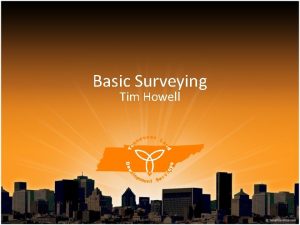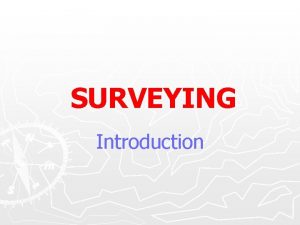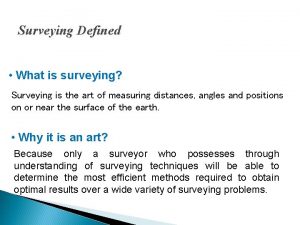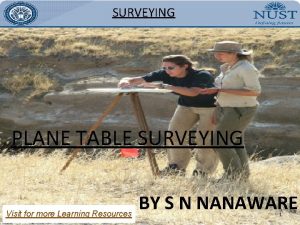Surveying the Machine Learning Landscape in Earth Sciences











- Slides: 11

Surveying the Machine Learning Landscape in Earth Sciences Katrina Virts, Ashlyn Shirey, George Priftis, Ankur Kumar, Muthukumaran Ramasubramanian, Hassan Muhammad, Ashish Acharya University of Alabama in Huntsville Rahul Ramachandran*, Manil Maskey NASA/MSFC EGU 2020 May 8, 2020

Overview of the Study Context Several recent papers have investigated different challenges in applying machine learning (ML) techniques to Earth science problems. The challenges listed range from interpretability of the results to computational demand to data issues. Goal In this paper, we focus on specific challenges listed in the review papers that are centered around training data, as the size of training data is important in applying deep learning (DL) techniques. Approach We are in the process of conducting a literature survey to better understand these challenges as well as to understand any trends. As part of this survey, our review has encompassed Earth science papers from AGU, AMS, IEEE and SPIE journals covering the last ten years and focused on papers that utilize supervised ML techniques.

Trend Analysis The use of supervised machine learning techniques in Earth science research has increased significantly in the last decade. The number of atmospheric science papers (i. e. , from AMS journals) using ML approaches has increased by over 60%. Across all of Earth science even larger changes have occurred, including a >90% increase in AGU papers and a >10 -fold increase in IEEE papers using ML.

Trend Analysis Linear regression is the most established of the supervised ML techniques included in this review; it is used in ~75% of the surveyed papers. This figure shows the 10 -year trend for ML algorithms other than linear regression. Initially, the number of AGU and AMS papers is similar, but the increasing separation between them indicates the more rapid adoption of newer ML methods by the broader Earth science community. This motivates us to look deeper at ML usage within various Earth science sectors.

Trend Analysis This chart shows the number of papers from each journal that use supervised ML techniques. By this metric, atmospheric science, hydrology, and ocean science have most frequently used supervised ML. But this chart does not tell the whole story.

Trend Analysis In this chart, the number of supervised ML papers from the previous chart is divided by the total number of papers published in each journal during the 10 -year window covered by the literature survey. This gives a view of the prevalence of the use of supervised ML in each research domain. The biogeoscience and land surface research communities lead in this area: over 20% of papers published in Global Biogeochemical Cycles, JGR Biogeosciences, JGR Earth Surface, and Water Resources Research use supervised ML techniques, including over 35% of the papers in JGR Biogeosciences.

Two-Year Deep Dive The availability of labeled training data in Earth science is reflected in the number of training data used in supervised analysis. In addition to the 10 -year analysis above, we have manually extracted from AGU papers from the years 2018 -2019 other relevant information including the ML algorithm that was applied, the number of labeled training data, and the data type (model output, satellite, in situ, reanalysis, etc. ). In the papers we surveyed, most ML algorithms were trained using hundreds (the order 102, or 100 -999) of labeled samples. However, for some applications using model output or large, established datasets, the number of training data ranged several orders of magnitude greater.

Two-Year Deep Dive The lack of training data is particularly acute in biogeoscience studies, where the log-mean sample size is equivalent to ~350. In contrast, training data sizes in atmospheric science and solid Earth studies are more than an order of magnitude larger.

Two-Year Deep Dive Closely related to the number of training data is the data type. Across Earth science, in situ data (e. g. , meteorological station data, streamflow gauges, buoys, seismic waveforms, etc. ) are most commonly used to train ML algorithms. Although large archives of satellite data are available, these data are used in ML applications less often than in situ data and model output. Reasons for this may include the lack of spatiotemporal continuity in low-Earth orbit satellite data and the amount of necessary preprocessing. The leastused data types in supervised ML analysis are airborne and laboratory data, suggesting that those airborne datasets large enough for ML purposes may be under-utilized.

Two-Year Deep Dive For most sub-domains, the majority of ML algorithms are trained using in situ data, with additional frequent use of model output and satellite data. Atmospheric science studies also frequently use reanalysis data, while ocean studies use satellite and in situ data approximately equally. The use of data derived from physical samples is more frequent in biogeoscience research than any other sub-domain, while solid Earth studies are the most likely of any sub-domain to use laboratory data.

Questions? Please contact: Rahul Ramachandran rahul. ramachandran@nasa. gov
 Machine learning landscape
Machine learning landscape Human sciences vs natural sciences tok
Human sciences vs natural sciences tok Concept learning task in machine learning
Concept learning task in machine learning Analytical learning in machine learning
Analytical learning in machine learning Pac learning model in machine learning
Pac learning model in machine learning Machine learning t mitchell
Machine learning t mitchell Inductive vs analytical learning
Inductive vs analytical learning Combining inductive and analytical learning
Combining inductive and analytical learning Instance based learning in machine learning
Instance based learning in machine learning Inductive learning machine learning
Inductive learning machine learning First order rule learning in machine learning
First order rule learning in machine learning Lazy vs eager
Lazy vs eager
